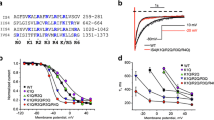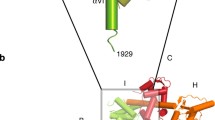Abstract
Modulation of the L-type Ca2+ channel (LTCC) by sorcin was investigated by measuring the L-type Ca2+ current (I Ca,L) in isolated rabbit ventricular myocytes using ruptured patch, single electrode voltage clamp in the absence of extracellular Na+. Fifty millimolars EGTA (170 nM Ca2+) in the pipette solution buffered bulk cytoplasmic [Ca2+], but retained rapid Ca2+-dependant inactivation of I Ca,L,. Recombinant sorcin (3 μM) in the pipette significantly slowed time-dependant inactivation (τ fast: 8.8 ± 0.9 vs. 15.1 ± 1.7 ms). Sorcin had no significant effect on I Ca,L, after inhibition of the sarcoplasmic reticulum (SR). Using 10 mM 1,2-bis(o-N,N,N′,N′-tetraacetic acid (170 nM Ca2+), I Ca,L inactivation was then determined by a Ca2+ -independent, voltage-dependant process. Under these conditions, 3 μM sorcin speeded up inactivation. A similar effect was observed by substitution of Ca2+ with Ba2+. Down-regulation of endogenous sorcin to 27 ± 7% using an RNAi adenoviral vector slowed inactivation of I Ca,L by ∼42%. The effects of sorcin on voltage-dependant inactivation were mimicked by a truncated form of the protein containing only the Ca2+-binding domain. This data is consistent with two independent actions of sorcin on the LTCC: (1) slowing Ca2+-dependant inactivation and (2) stimulating voltage-dependant inactivation. The net effect of sorcin on the time-dependent inactivation of I Ca,L was a balance between these two effects. Under normal conditions, sorcin slows I Ca,L inactivation because the effects of Ca2+-dependant inactivation out-weigh the effects on voltage-dependant inactivation.








Similar content being viewed by others
References
Meyers MB, Spengler BA, Chang T-D, Melera PW, Biedler JL (1985) Gene amplification-associated cytogenic aberrations and protein changes in vincristine-resistant Chinese hamster, mouse and human cells. J Cell Biol 100:588–597
Van der Bliek AM, Meyers MB, Biedler JL, Hes E, Borst P (1986) A 22-kd protein (sorcin/V19) encoded by an amplified gene in multidrug-resistant cells, is homologous to the calcium-binding light chain of calpain. EMBO J 5:3201–3208
Meyers MB, Pickel VM, Sheu S-S, Sharma VK, Scotto KW, Fishmann GI (1995) Association of sorcin with the cardiac ryanodine receptor. J Biol Chem 270:26411–26418
Meyers MB, Puri TS, Chien AJ, Gao T, Hsu P-H, Hosey M, Fishmann GI (1998) Sorcin associates with the pore-forming subunit of voltage-dependent L-type Ca2+ channels. J Biol Chem 273:18930–18935
Farrell EF, Antaramian A, Rueda A, Gomez AM, Valdivia HH (2003) Sorcin inhibits calcium release and modulates excitation–contraction coupling in the heart. J Biol Chem 278(36):34660–34666
Siedler T, Miller SLW, Loughery CM, Kanie A, Burow A, Kettlewell S, Teucher N, Wagner S, Kogler H, Meyers MB, Hasenfuss G, Smith GL (2003) Effects of adenovirus-mediated sorcin overexpression on excitation–contraction coupling in isolated rabbit cardiomyocytes. Circ Res 93:132–139
Meyers MB, Fischer A, Sun J-Y, Lopes CMB, Rohacs T, Nakamura TY, Zhou Y-Y, Lee PC, Altschuld RA, McCune SA, Coetzee WA, Fishman GI (2003) Sorcin regulates excitation–contraction coupling in the heart. J Biol Chem 278(31):28865–28871
Collis LP, Meyers MB, Zhang J, Phoon CKL, Sobie EA, Coetzee WA, Fishmann GI (2007) Expression of a sorcin missense mutation in the heart modulates excitation–contraction coupling. FASEB J 21:475–487
Matsumoto T, Hisamatsu Y, Ohkusa T, Inoue N, Sato T, Suzuki S, Ikeda Y, Matsuzaki M (2005) Sorcin interacts with sarcoplasmic reticulum Ca2+-ATPase and modulates excitation–contraction coupling in the heart. Basic Res Cardiol 100:1–13
Franzini-Armstrong C, Protasi F, Ramesh V (1999) Shape size and distribution of Ca2+ release units and couplons in skeletal and cardiac muscle. Biophys J 77:1528–1539
Gathercole DV, Colling DJ, Skepper JN, Takagishi Y, Levi AJ, Severs N (2000) Immunogold-labelled L-type calcium channels are clustered in the surface plasma membrane overlying junctional sarcoplasmic reticulum in guinea-pig myocytes—implications for excitation–contraction coupling in cardiac muscle. J Mol Cell Cardiol 32:1981–1994
Langer GA, Peskoff A (1996) Calcium concentration and movement in the dyadic cleft space of the cardiac ventricular cell. Biophys J 70:1169–1182
Eckert R, Chad JE (1984) Inactivation of Ca channels. Prog Biophys and Mol Biol 44:215–267
Hadley RW, Lederer WJ (1991) Ca2+ and voltage inactivate Ca2+ channels in guinea-pig ventricular myocytes through independent mechanisms. J Physiol 444:257–268
Sham JSK, Cleeman L, Morad M (1995) Functional coupling of Ca2+ channels and ryanodine receptors in cardiac myocytes. PNAS 92:121–125
Pott C, Yip M, Goldhaber JI, Philipson KD (2007) Regulation of cardiac L-type Ca2+ current in Na+–Ca2+ exchanger knockout mice: Functional coupling of the Ca2+ channel and the Na+-Ca2+ exchanger. Biophys J 92:1431–1437
McIntosh MA, Cobbe SM, Smith GL (2000) Heterogeneous changes in action potential and intracellular Ca2+ in left ventricular myocyte sub-types from rabbits with heart failure. Cardiovasc Res 45:397–409
Duncan L, Burton FL, Smith GL (1999) REACT: calculation of free metal and ligand concentrations using a Windows-based computer program. J Physiol 517P (Abstract)
Richard S, Tiaho F, Charnet P, Nargeot J, Nerbonne JM (1990) Two pathways for Ca2+ channel gating differentially modulated by physiological stimuli. Am J Physiol 27:H1872–H1881
Colotti G, Zamparelli C, Verzili D, Mella M, Loughery CM, Smith GL, Chiancone E (2006) The W105G and W99G sorcin mutants demonstrate the role of the D helix in the Ca2+-dependent interaction with annexin VII and the cardiac ryanodine receptor. Biochem 45:12519–12529
Soeller C, Cannell MB (2004) Analysing cardiac excitation–contraction coupling with mathematical models of local control. Prog Biophys Mol Biol 85:141–162
Naraghi M, Neher E (1997) Linearized buffered Ca2+ diffusion in microdomains and its implications for calculation of [Ca2+] at the mouth of a calcium channel. J Neurosci 17:6961–6973
Yuan W, Bers DM (1994) Ca-dependent facilitation of cardiac Ca current is due to Ca-calmodulin-dependent protein kinase. Am J Physiol 267:H982–H993
Hess P, Lansman JB, Tsien RW (1986) Calcium channel selectivity for divalent and monovalent cations; voltage and concentration dependence of single channel current in ventricular heart cells. J Gen Physiol 80:293–319
Guia A, Stern MD, Lakatta EG, Josephson IR (2001) Ion concentration-dependence of rat unitary L-type calcium channel conductance. Biophys J 80:2742–2750
Eisner DA, Trafford AW, Diaz ME, Overend CL, O’Neil SC (1998) The control of Ca release from the cardiac sarcoplasmic reticulum: regulation versus autoregulation. Cardiovasc Res 38:589–604
Hess P, Lansman JB, Tsien RW (1984) Different modes of Ca channel gating behaviour favoured by dihydropyridine Ca agonists and antagonists. Nature 311:538–544
Noceti F, Olcese R, Qin N, Zhou J, Stefani E (1998) Effect of Bay K 8644 (−) and the b2a subunit on Ca2+-dependnet inactivation in a1c Ca2+ channels. J Gen Physiol 111:463–475
Bracken N, Elkadri M, Hart G, Hussain M (2006) The role of constitutive PKA-mediated phosphorylation in the regulation of basal I Ca in isolated rat cardiac myocytes. Br J Pharm 148:1108–1115
Yue DT, Herzig S, Marban E (1990) b-adrenergic stimulation of calcium channels occurs by potentiation of high-activity gating modes. PNAS 87:753–757
Schroder F, Herzig S (1999) Effects of b2-adrenergic stimulation on single-channel gating of rat cardiac L-type Ca2+ channels. Am J Physiol 276:H834–H843
Tiaho F, Piot C, Nargeot J, Richard S (1994) Regulation of the frequency-dependent facilitation of L-type Ca2+ currents in rat ventricular myocytes. J Physiol 477:237–252
Findlay I (2002) b-adrenergic stimulation modulates Ca2+ and voltage-dependent inactivation of L-type Ca2+ channel currents in guinea-pig ventricular myocytes. J Physiol 541:741–751
Lokuta AJ, Meyers MB, Sander PR, Fishman GI, Valdivia HH (1997) Modulation of cardiac ryanodine receptors by sorcin. J Biol Chem 272:25333–25338
Smith GL, Elliott EE, Kettlewell S, Curries S, Quinn FR (2006) Na(+)/Ca(2+) exchanger expression and function in a rabbit model of myocardial infarction. J Cardiovasc Electrophys 17:S57–S63
Acknowledgements
The authors would like to thank Aileen Rankin and June Irvine for preparation of cardiomyocytes. This work was funded by the British Heart Foundation (Mark Fowler and Godfrey Smith) and the Deutsche Forschungsgemeinschaft (DFG, grant 1233/7-3 (Gerd Hasenfuß and Tim Seidler); the authors would also like to thank Carlotta Zamparelli and Daniela Verzili for help in generation and purification of recombinant proteins.
Author information
Authors and Affiliations
Corresponding author
Rights and permissions
About this article
Cite this article
Fowler, M.R., Colotti, G., Chiancone, E. et al. Complex modulation of L-type Ca2+ current inactivation by sorcin in isolated rabbit cardiomyocytes. Pflugers Arch - Eur J Physiol 457, 1049–1060 (2009). https://doi.org/10.1007/s00424-008-0575-5
Received:
Revised:
Accepted:
Published:
Issue Date:
DOI: https://doi.org/10.1007/s00424-008-0575-5




